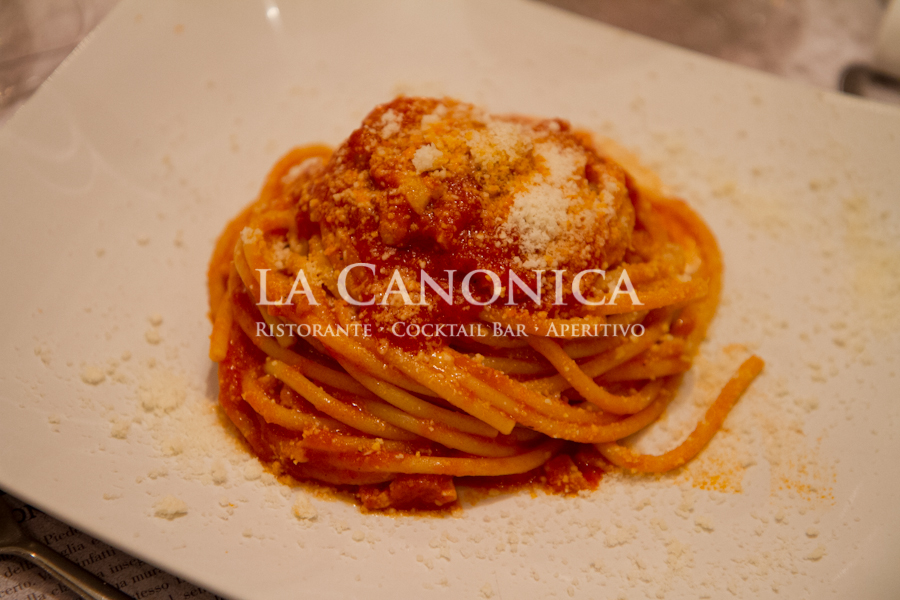Amatriciana (in Roman dialect matriciana because of the apheresis) is a pasta sauce typical of Roman osterias and trattorias. The ingredients are: guanciale, pecorino and pommidoro.
It is named after Amatrice, a small town in the province of Rieti.
The first written record of this dish comes to us from the cook Francesco Leonardi who, in 1816, served it at the pope's court.
[dropcap]In the 1800s, in the Ponte district (area of Piazza Navona area Ponte Sant'Angelo), there was an alley called de' Matriciani (after 1870 alley of the Amatriciani) and a square (today Piazza Lancellotti) where the Grici (Sabini) held markets, selling bread, cold cuts and cheeses from the Sibillini mountains; they then stopped near an inn called The Amatrician.[/dropcap]
[dropcap]This sauce is therefore the child of gricia (or griscia), a dish of spaghetti or macaroni seasoned with oil, pepper and barbozzo or guanciale, which originated in a town in the Rieti area named Grisciano. What is certain is that the addition of tomato sauce dates back to the late 17th century. The first written record of the use of all'amatriciana sauce to season pasta can be found in the cookbook of Roman cook Francesco Leonardi, who served it at the court of the Pope. It was a high-class coup: in the manner of the Matricians Leonardi imposed a popular dish at a banquet at the Quirinal Palace in honor of Francis I Emperor of Austria, organized by Pope Pius VII in April 1816. Roman by birth, Leonardi had worked in the courts in France with Richelieu, as well as in Poland, Turkey, Germany, and England, until he reached the court of Catherine II of Russia as a cook. In 1790 he wrote a 7-volume encyclopedia of cooking, L'Apicius Moderno ossia l'arte di apprestare ogni sorta di vivande.[/dropcap]
[dropcap]Leonardi, who wanted to be Enlightenment and modern (in the sense of giving a scientific aspect to his work) rivals Carême (with whom he clashed at luncheons during the Treaty of Vienna) and Alexandre Dumas, compiling a list of 3,000 recipes with stories and suggestions. He was the first cook to use tomatoes permanently and boasts as his own the invention of the classic Neapolitan combination of pasta with tomato sauce. His sauce, made from seedless tomatoes and simmered by adding onions, celery, garlic, and basil, is unchanged to this day. He certainly gave credit to amatriciana, turning a popular dish like gricia into a fashionable one. His version includes maccaroni, guanciale di Amatrice, pommidori, onion and pecorino cheese. From then until the early 1900s, the popularity of this dish was undisputed in Rome, so much so that several hosts took the nickname matriciani to indicate their profession. It is such a famous dish that in 2002 even chef Ferran Adrià included it on the menu at El Bulli.[/dropcap]
The simplicity of the ingredients of this dish, which have now become famous in culinary circles, is so suavely encapsulated in the verses that the poet Carlo Baccari (1878 - 1978) dedicated to it.
[quotation]... And there among the herds, by magic hand, joyful thou didst arise in the strangest way the meek sheep and the good pig, they bestowed cheese and cheek together[/quote].
Charles Baccari
[quote]"LA MATRICIANA MIA" DER SOR ALDO FABRIZI
Fry in a staggered pan,
Onion, ojo, infused ginger,
half a pound of smoked bacon
And a half de bacon arotolata.
To the point that this stuff is browned,
splash it with fragrant vinegar
And to an open flame, when it's vaporized,
Put the concentrated preserve.
Next to the nut that gives it flavor,
li pommidori fresh San Marzano,
With a tuft of basil for smell.
And sick as the sauce makes the little eyes,
along with pecorino and parmesan cheese,
Season the spaghetti with prescia.[/quote]
Aldo Fabrizi

